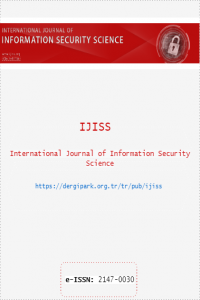Minimal Linear Codes with Few Weights and Their Secret Sharing
Minimal Linear Codes with Few Weights and Their Secret Sharing
___
- [1] A. Ashikhmin and A. Barg. Minimal vectors in linear codes. IEEE Transactions on Information Theory, 44(5):2010–2017, (1998).
- [2] G. R. Blakley et al. Safeguarding cryptographic keys. In Proceedings of the national computer conference, volume 48, pages 313–317, 1979.
- [3] A. Calderbank and J. Goethals. Three-weight codes and association schemes. Philips J. Res, 39(4-5):143–152, 1984.
- [4] R. Calderbank and W. Kantor. The geometry of two-weight codes. Bulletin of the London Mathematical Society, 18(2):97– 122, 1986.
- [5] C. Ding. Linear codes from some 2-designs. IEEE Transactions on information theory, 61(6):3265–3275, 2015.
- [6] C. Ding. A construction of binary linear codes from boolean functions. Discrete mathematics, 339(9):2288–2303, 2016.
- [7] K. Ding and C. Ding. A class of two-weight and threeweight codes and their applications in secret sharing. IEEE Transactions on Information Theory, 61(11):5835–5842, 2015.
- [8] O. Goldreich, S. Micali, and A. Wigderson. How to play any mental game. In Proceedings of the nineteenth annual ACM symposium on Theory of computing, pages 218–229. ACM, 1987.
- [9] J. L. Massey. Minimal codewords and secret sharing. In Proceedings of the 6th joint Swedish-Russian international workshop on information theory, pages 276–279, 1993.
- [10] R. J. McEliece and D. V. Sarwate. On sharing secrets and reedsolomon codes. Communications of the ACM, 24(9):583–584, 1981.
- [11] S. Mesnager, F. Ozbudak, and A. Sınak. A new class of three- ¨ weight linear codes from weakly regular plateaued functions. In Proceedings of the Tenth International Workshop on Coding and Cryptography (WCC) 2017.
- [12] S. Mesnager, F. Ozbudak, and A. Sınak. Linear codes from ¨ weakly regular plateaued functions and their secret sharing schemes. Designs, Codes and Cryptography, 87(2-3):463–480, 2019.
- [13] S. Mesnager, A. Sınak, and O. Yayla. Three-weight minimal linear codes and their applications. In Proceedings of the Second International Workshop on Cryptography and its Applications (2IWCA’19), pages 216-220, 19-20 June 2019, Oran, Algeria.
- [14] S. Mesnager and A. Sınak. Several classes of minimal linear codes with few weights from weakly regular plateaued functions. IEEE Transaction on Information Theory, DOI: 10.1109/TIT.2019.2956130, 2019.
- [15] J. Pieprzyk and X. Zhang. Ideal secret sharing schemes from mds codes. In Proc. 5th Int. Conf. Information Security and Cryptology (ICISC 2002), pages 269–279, 2002.
- [16] A. Renvall and C. Ding. The access structure of some secretsharing schemes. In Information Security and Privacy, pages 67–78. Springer, 1996.
- [17] B. Schoenmakers. A simple publicly verifiable secret sharing scheme and its application to electronic voting. In Annual International Cryptology Conference, pages 148–164. Springer, 1999.
- [18] A. Shamir. How to share a secret. Communications of the ACM, 22(11):612–613, 1979.
- [19] A. Sınak. Three-weight and four-weight minimal linear codes and their secret sharing schemes. Submitted to the international journal, 2019.
- [20] C. Tang, N. Li, Y. Qi, Z. Zhou, and T. Helleseth. Linear codes with two or three weights from weakly regular bent functions. IEEE Transactions on Information Theory, 62(3):1166–1176, 2016.
- [21] C. Tang, C. Xiang, and K. Feng. Linear codes with few weights from inhomogeneous quadratic functions. Designs, Codes and Cryptography, 83(3):691–714, 2017.
- [22] C.-N. Yang and J.-B. Lai. Protecting data privacy and security for cloud computing based on secret sharing. In 2013 International Symposium on Biometrics and Security Technologies, pages 259–266. IEEE, 2013.
- [23] Y. Zheng and X.-M. Zhang. Plateaued functions. In ICICS, volume 99, pages 284–300. Springer, 1999.
- [24] Z. Zhou, N. Li, C. Fan, and T. Helleseth. Linear codes with two or three weights from quadratic bent functions. Designs, Codes and Cryptography, 81(2):283–295, 2016.
- [25] G. Zyskind, O. Nathan, et al. Decentralizing privacy: Using blockchain to protect personal data. In 2015 IEEE Security and Privacy Workshops, pages 180–184. IEEE, 2015.
- Yayın Aralığı: Yılda 4 Sayı
- Başlangıç: 2012
- Yayıncı: Şeref SAĞIROĞLU
Black Hole Attack in Manets: Defending and Detecting Techniques
Jaspreet KAUR, Rajneesh TALWAR, Ashok Kumar GOEL
Scalability Evaluation of Trust and Reputation Models for Wireless Sensor Networks
Fingerprint Forensics in Crime Scene: A Computer Science Approach
Minimal Linear Codes with Few Weights and Their Secret Sharing
Sıhem MESNAGER, Ahmet SINAK, Oguz YAYLA
Analysis of cyber-attacks in IoT-based critical infrastructures
